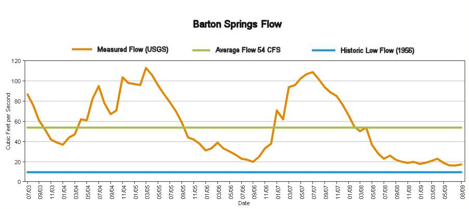Could Barton Springs Dry Up?
NULL

A memo circulating at Austin City Hall raises the prospect of Barton Springs basically drying up by the end of 2010 if the current drought persists. Asher Price has the story over at his Statesman Salsa Verde blog.
“With the drought approaching the worst on record, we are in unchartered territory,” [Victoria Li P.E., Director of the Austin Watershed Protection Department] wrote. “We do not know exactly how the aquifer will respond to continued lack of rainfall, if flow continues to decline at a constant, slower or faster rate as the drought deepens.”
The department projects Barton Springs flow will drop to 12 cfs by the end of this year and 5 cfs by December 2010 if the drought persists.
“If the drought persists for long enough, the springs could cease flowing,” she wrote. “Significant rainfall might completely erase fears of the current drought or only delay them if drought conditions continue.”
The conditions have serious consequences for the endangered Barton Springs salamander. The 2009 count in Eliza Springs is down to 159 (there were 703 in the 2008 count).
“It is unknown whether salamander populations would rebound from extended flow conditions below 5 cfs and the associated low oxygen levels,” Li wrote.

As Li notes, there is considerable uncertainty in predicting how Barton Springs would respond to a prolonged drought. The historical point of comparison is the drought of the 50s during which Barton Springs dwindled to 9.6 cfs in March 1956. But there was much less pumping from the aquifer then. The memo states:
Today, various municipal and private users remove 10 to 11 cfs from the aquifer through permitted pumping. This level of pumping is a concern since it is equivalent to the spring flow rate during the worst of the 1950s drought-of-record.
In other words, all other things being equal, if this drought deepens to the level of 1956, we could reasonably expect the flow at the Springs to approach zero. I called David Johns, a hydrogeologist with the City of Austin, to ask if this assumption was accurate.
“I think that’s the ultimate implication,” he said.
It’s hard to see how the endangered Bartons Springs Salamander could survive at that point.
However, Johns pointed out that the Barton Springs/Edwards Aquifer Conservation District (BSEACD) is considering rules [large .pdf] that could require all permitted well-users to “completely curtail” pumping during an “emergency” stage of drought, defined in the draft rules as “sustained flow at Barton Springs being at or below 10 cubic feet per second (cfs) on a 30-day running average basis.”
That would relieve some pressure on the Springs.
Like everyone else, I’m keeping my fingers crossed that El Niño produces some serious rainfall this fall and winter. But there’s danger in holding out hope that Mother Nature will solve our problems. Water managers call it the hydro-illogical cycle: In dry times, we panic and decide that have to do something, but then it rains and we go back to being complacent.

Droughts are a reality of life in Texas but they’re likely to get harder and harder to cope with unless there’s a real, sustained effort to change our ways.


